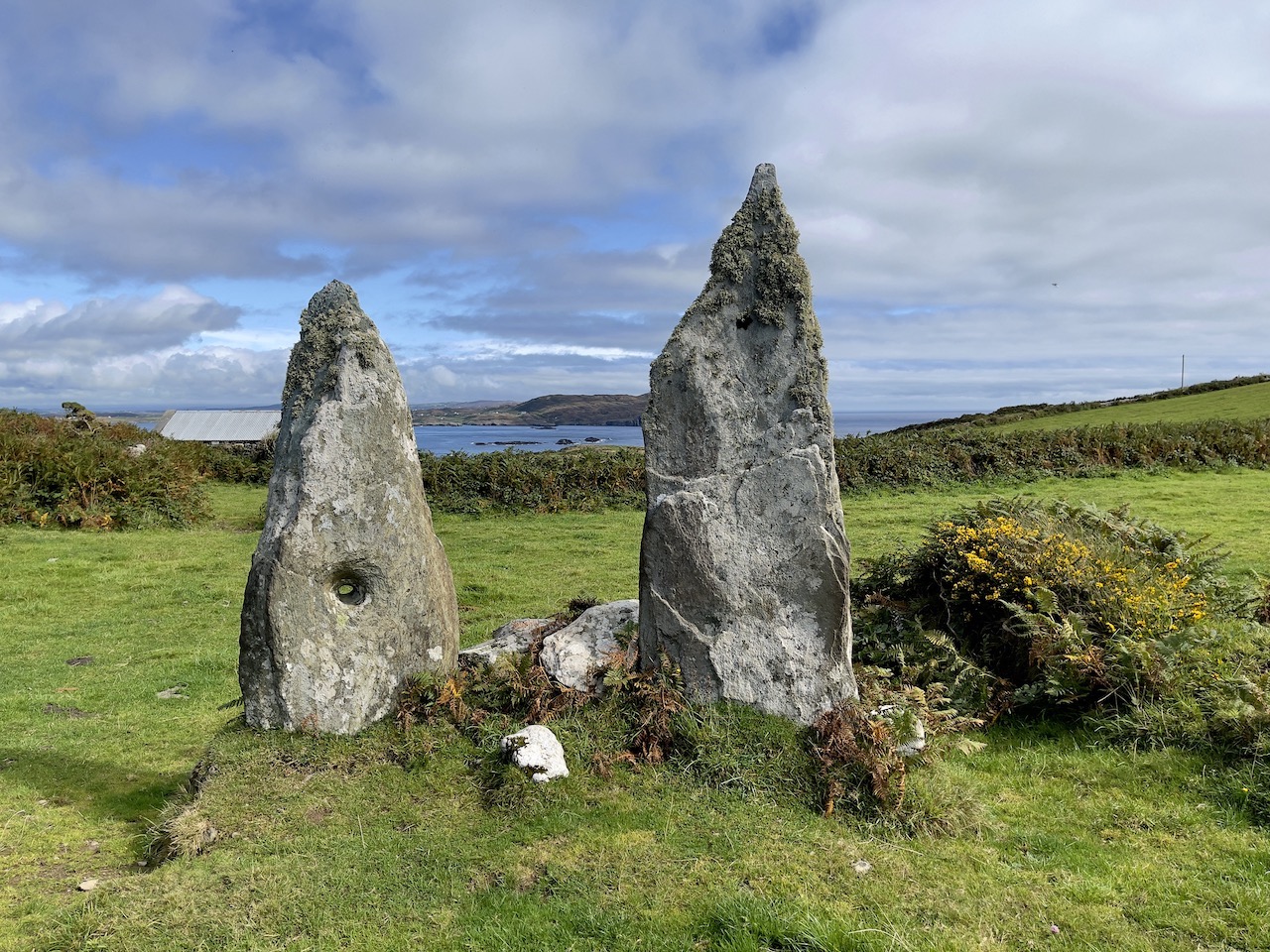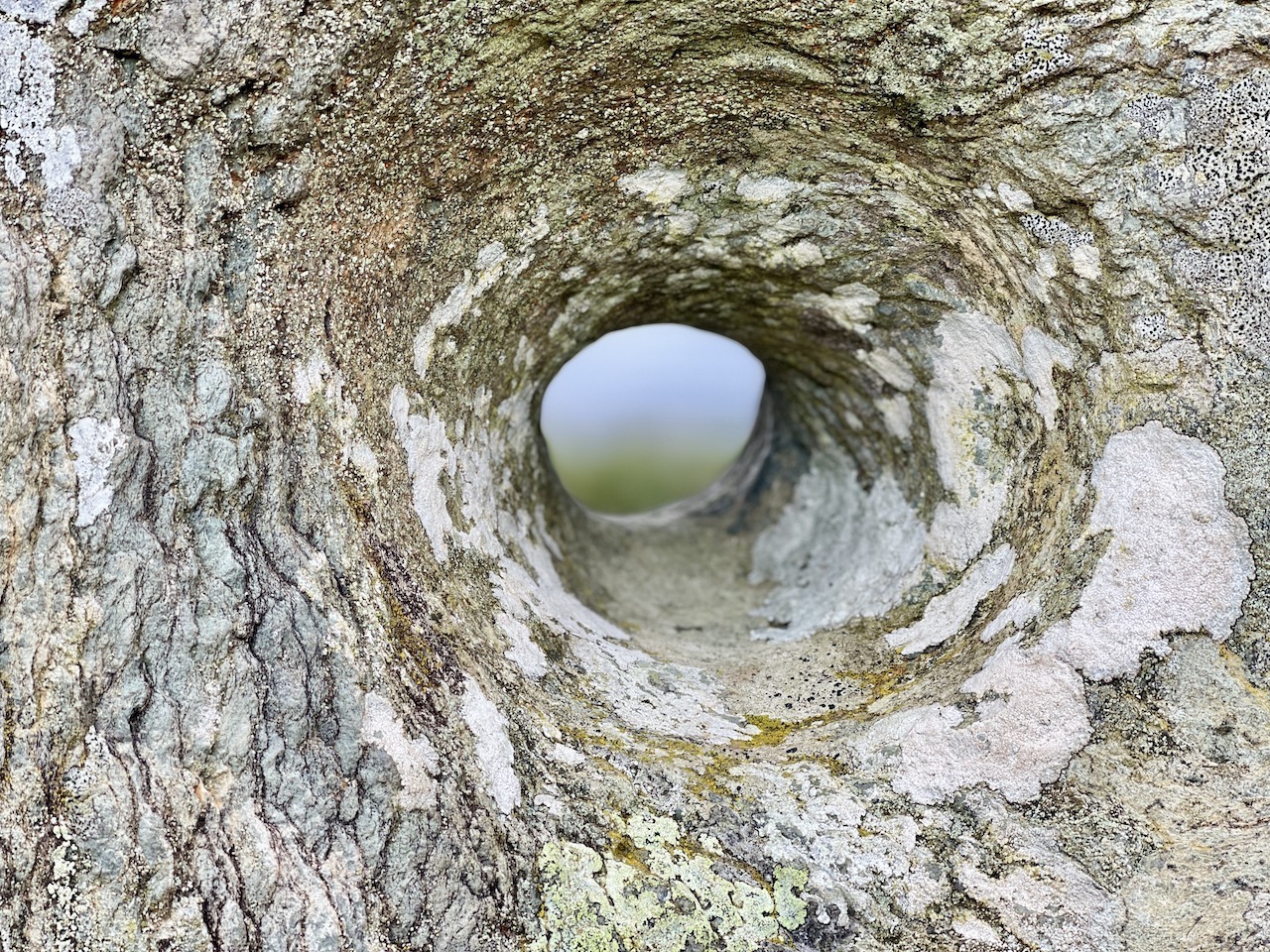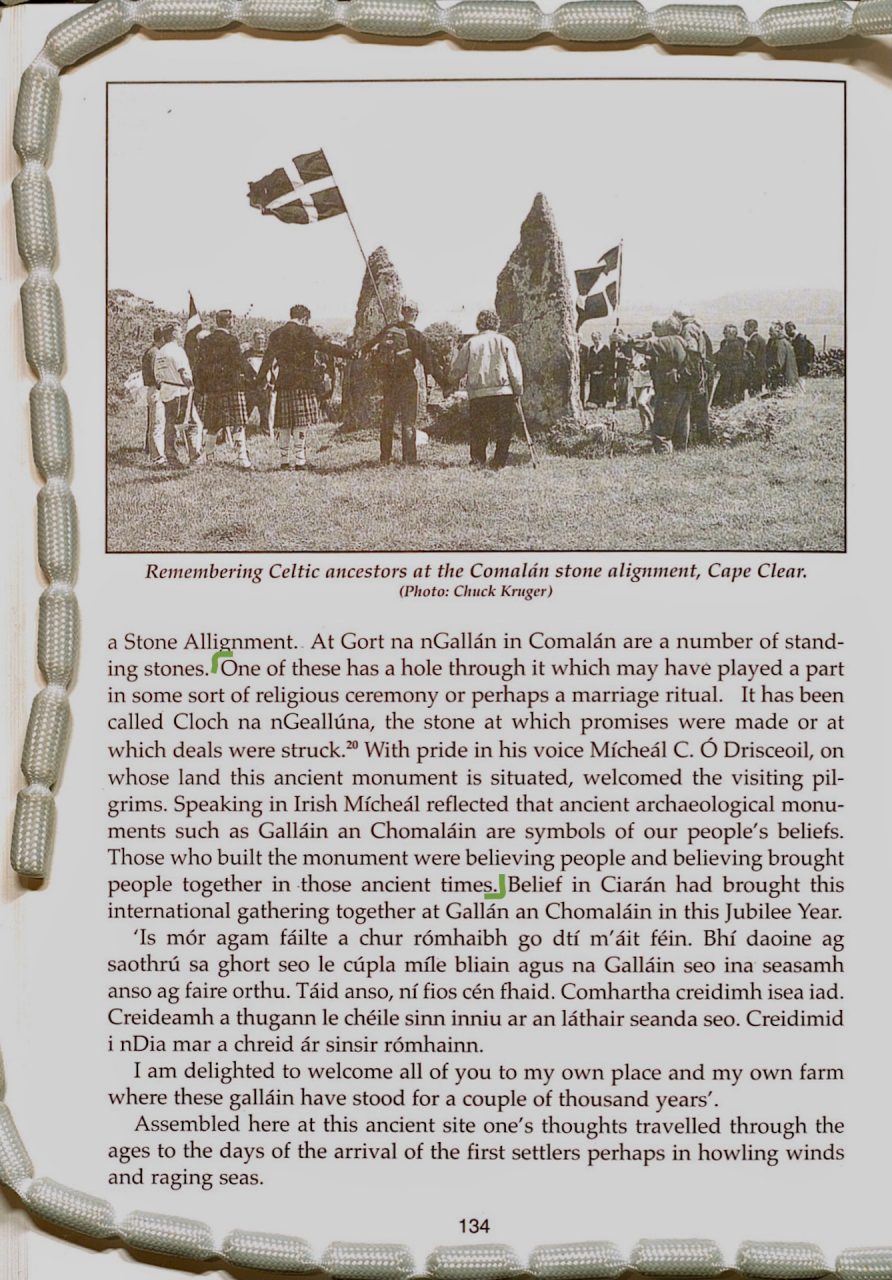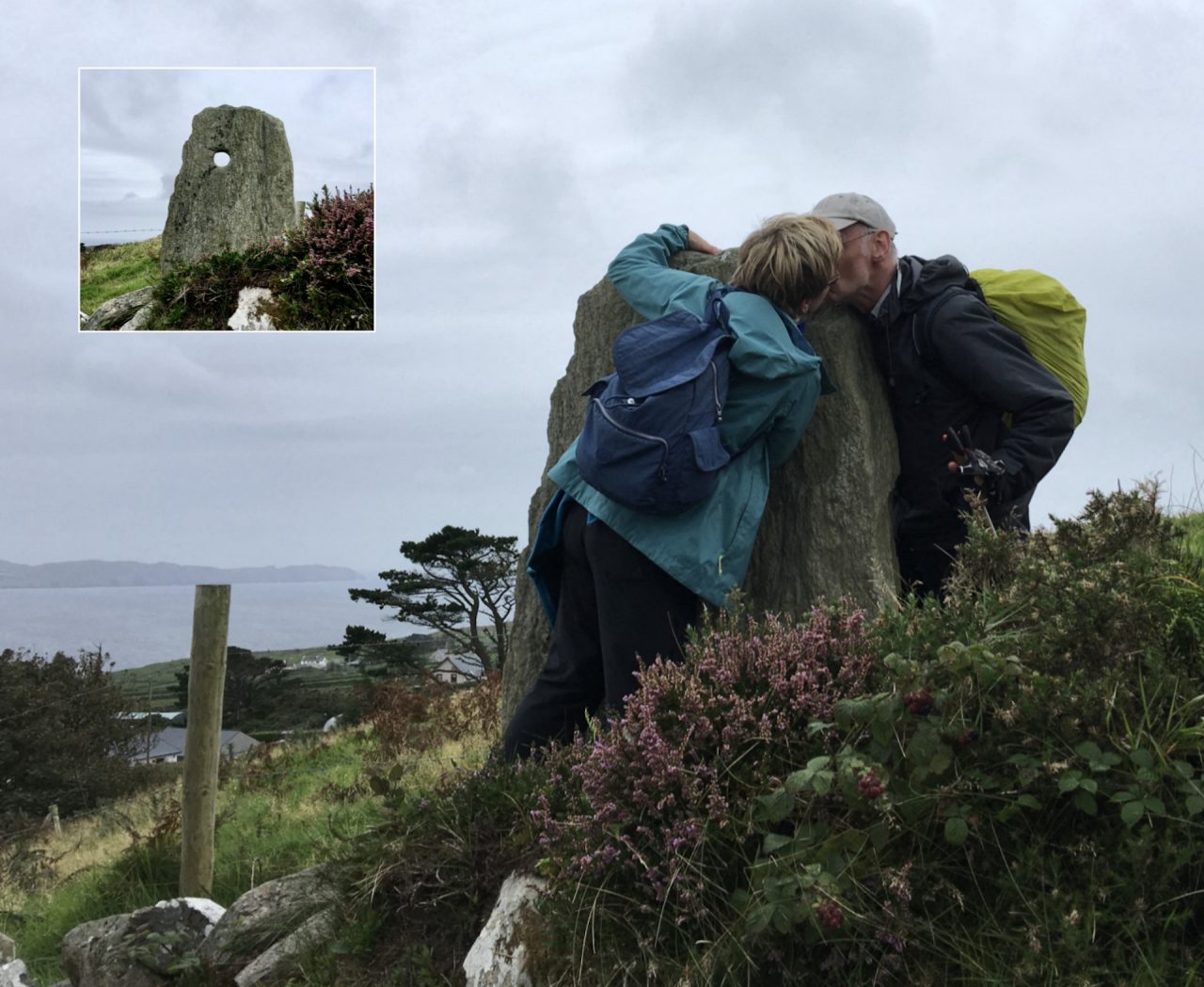This story / page is available in:
![]() German
German
View of south harbour, Cape Clear Island
Islands are her passion. Irlandnews author Sandra Boettcher reports about the remarkable old stone monuments of Cape Clear.
In late summer, I spent five days on Cape Clear Island and came back with many impressions that make my list love for the islands longer. Besides the attraction of being surrounded by water and far out, I love the rugged nature of remote places. There is little modern stress here. I enjoy the simplicity, feel a deep contentment when everything is quiet except for the sounds of nature, the music of the wind, the sea and the birds.
I knew Cape Clear from several visits (you’ll find a brief island description below). This trip was focused on the prehistoric sites, in addition to the hiking tours where I feel so comfortable and free: I wanted to find out what charisma these special places have on me, and among other things, I spent a lot of time at the ancient engagement and wedding stones.
The impressive Marriage Stones stand in a pasture below a rocky knoll on the eastern end of the island.
 Marriage Stones Cape Clear (Galláin an Chomalaín or Cloch na nGeallúna)
Marriage Stones Cape Clear (Galláin an Chomalaín or Cloch na nGeallúna)
Originally there were four, but today only two stones stand upright. One, with a hole in the middle, has always been known as Cloch na Geallona, the “engagement and wedding stone”.
Legend has it that in earlier times this stone was used to seal a vow of betrothal. In early Ireland, when Brehon laws, the native legal system in early medieval Ireland, were still in effect in pre-Christian times, people were very practical about marriage:
A couple could marry for a year and a day and then, if they were not satisfied with the partnership, could return after that time and break their vows without shame or stain. This law was also applied if the man was impotent. If there were children, they went to the mother’s clan.
The hole in the wedding stone is usually narrow on one side and wide on the other. The woman slipped her hand through the narrow opening, and the man grasped it through the wide side. They joined hands to declare either their engagement or their marriage vows.
 Hole Marriage Stone Cape Clear
Hole Marriage Stone Cape Clear
On Cape Clear it is said that these Trysting Stones or Marriage Stones, with a third one between them, probably symbolize three warriors who have been put under a magical spell.
Another story revolves around a black horse that inhabits the field where the stone is located. According to this legend, a young couple was married at the stone, but the groom committed adultery on the wedding night. For this act he was cursed by the stone to spend eternity as a horse, never to die and never to leave the field. This legend does not come from Cape Clear, but from a small village in County Antrim, Northern Ireland.
Archival information from the University of Cork
The following collection dates from 1937-39 and is the outcome of an innovative project supervised by the Irish Folklore Commission. In conjunction with the Department of Education and the Irish National Teachers’ Organisation, senior Primary School children recorded 750,000+ pages of local history and oral tradition from across the 26 counties of the Irish Free State. From the collection, an excerpt about the Cape Clear wedding stone:
Handwritten essay by a primary school pupil in 1938*, Clochar na Trócaire (Convent of Mercy), Skibbereen
“Wedding customs. Near the north end of the island of Cleire, a pillarstone, Gallaun, may be seen standing upright and about four feet high. In the centre there is a circular opening; there is an ancient tradition connected with it. In former times this was a marriage stone where lovers met and became engaged. As no jeweller flourished on the island and engagement rings were not to be obtained, the lovers adopted the custom of plighting their troth by shaking hands through the circular opening. The mutual vows made on such occasions were strictly observed. This Gallaun is looked upon as a venerable relic connected in someway or another with the worship of the Druids”.
Students and enthusiasts of history from Cornwall accepted an invitation from Cape Clear Museum Society in 2,000, also stopped at the Wedding Stones** during a pilgrimage (in honour of St. Kieran, who had brought the message of Christianity to their places).
Pilgrimage, flags from Cornwall and Ireland, commemoration of Celtic ancestors at the Comalán stone row, “wedding stones”
…In Gort na nGallán in Comalán are a number of standing stones. One of these has a hole through it which may have played a part in some sort of religious ceremony or perhaps a marriage ritual. It has been called Cloch na nGealluna, the stone at which promises were made or at which deals were struck. With pride in his voice Mícheál C. Ó Drisceoil, on whose land this ancient monument is situaeted, welcomed the visiting pilgrims. Speaking in Irish Mícheál reflected that ancient archaeological monuments such as Galláin an Chomaláin are symbols of our people’s beliefs. Those who built the monuments were believing people and believing brought people together in those ancient times….
The pilgrims stood together, honouring their ancestors and had many questions: how laborious and exhausting it must have been to move those big stones and erect them? How long did it take? Where did they bring the stones from? Why did they put the stones together in this way? What was their belief?
Then as now: the attraction of mystical places
There are many people who are looking for very personal places of power. Often, we are drawn to a secluded spot in nature to enjoy the silence, to admire the landscape and to linger for a moment. A personal place of peace can also be a Celtic stone circle, a burial site or a historical place to go into oneself, to find peace. Perhaps to perform a ritual there, make promises, celebrate anniversaries, offer a prayer or send wishes.
In any case, the marriage or engagement stones continue to attract couples today who want to make or renew their vows.
Confirming mature love: Married couple at the Caherulagh Marriage Stone, Sheep’s Head Peninsula
Ancient stones – signposts today?
What purpose do you think the ancient stones served? They remain mysterious. They are grave markers, memorial stones, boundary stones, sun markers. They are silent witnesses, can tell many stories. Stones remind us of happiness and suffering.
I feel a deep aesthetic appreciation, I am left with impressive moments with many thoughts and certainly I will firmly anchor this place in my memories as a special space.
A short description of the island: Cape Clear
Cape Clear Island (also Clear Island; gael. Cléire or Oileán Chléire), the southernmost inhabited (Gaeltacht) island in Ireland, is about three miles long, nearly two miles wide and rises from the sea like a mighty whale. Currently, about 100 inhabitants live on the island. In summer, the number grows to several hundred when Irish students attend Gaelic colleges or people move into summer vacation homes. The island is known for being the birthplace of the missionary St. Ciaran (352 AD), its patron Saint. There are many prehistoric finds there, standing stones, the ruins of O’Driscoll Castle, a 12th century church….
Two harbours connect the island with the mainland. The north harbour is the destination of ferries (45-minute-drive from the mainland), the south harbour is visited by yachts and sailboats. Hikers, amateur birdwatchers and ornithologists, day tourists come here. The scenery is breathtaking with magnificent views of Roaringwater Bay, the famous Fastnet Rock lighthouse and the Mizen Peninsula. Heather and gorse cover the rugged hilly landscape.
Notes and Photo Credits:
All photos: Sandra Boettcher
* Handwritten essay 1938 – Courtesy of the UCC / from the archives of the National Folklore Collection University College Dublin, translation Sandra Boettcher
**”A Celtic Pilgrimage on Cape Clear” by Éamon Lankford, Mizen Journal (Mizen Archaeological and Historical Society) No. 9, 2021 – by courtesy of Special Collections & Archives, UCC (University College Cork), Library, translation Sandra Boettcher
Reading tip: Fionola Finlay and Robert Harris live at Roaringwater Bay in West Cork, Ireland. In their blog Roaringwater Journal they also explore the landscape and archaeology of their adopted home of West Cork (entry 8/14/2014, Monoliths, Mysteries and Marriages): CLICK
This story / page is available in:
![]() German
German







Thank you so much for your historical and informative article about the Marriage/Comalán Stones. As I recently moved to the house directly above them, up the little hill, it is of special interest for me and I love to read those old stories..
Vielen herzlichen Dank nochmal und liebe Grüße,
Eva Klöcker
I am very pleased, dear Eva. I wish you a great time on Cape Clear. Maybe we will see each other there one day…
Viele Grüße aus Norddeutschland, Sandra
Great history I walked around cape clear and came upon the stones by chance I was able to get a brief history that’s all on my return to Skibbereen but am if the above has been most enlightening I hope everyone who had commmented on my Ohio read it
Thankyiu
Glad to read you enjoyed the article, Mabel. The Marriage Stones are undoubtedly something special, in terms of history and stories around it.